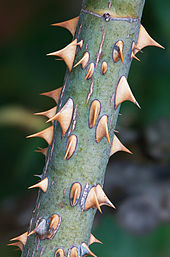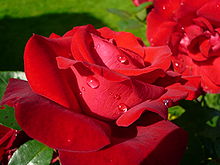Rose
| Rosa | |
|---|---|

| |
| 'Bridal Pink', a hybrid Tea rose at the Morwell Rose Garden | |
| Scientific classification | |
| Kingdom: | |
| Division: | |
| Phylum: | |
| Class: | |
| Order: | |
| Family: | |
| Subfamily: | |
| Genus: | Rosa L.
|

The rose is a type of flowering shrub. Its name comes from the Latin word Rosa.[1]
There are over three hundred species and tens of thousands of cultivars. The flowers of the rose grow in many different colors, from the well-known red rose or yellow rose and sometimes white or purple rose.

Roses belong to the family of plants called Rosaceae. All roses were originally wild: they grew in North America, Europe, northwest Africa and many parts of Asia and Oceania. There are over 150 different species of roses. The wild rose species can be grown in gardens, but most garden roses are cultivars, which have been selected by people.[2]
Over hundreds of years they have been specially bred to produce a wide variety of growing habits and a broad range of colours from dark red to white including as well yellow and a bluish/lilac colour. Many roses have a strong, pleasant scent.
Most roses have spines (incorrectly called prickles) on their stems. This is a common defense system in plants.
Rose bushes are able to live in a wide variety of conditions. The fruit of the rose is called a hip or a haw or a hep. Some roses have decorative hips.
Roses in legend and in history
[change | change source]Roses are widely used across the world as symbols of love, sympathy or sorrow. Rose is widely used as a girl's name.[3]
The rose was sacred to Venus. Venus was the Roman goddess of love and beauty.[3] It was also linked with Cupid (son of Venus). He was the Roman god of desire – in one myth, he dropped nectar and the nectar bubbled up from the ground as roses.[3] The rose was also sacred to Bacchus. He was the Roman god of wine.[3]
Rich Romans would lie on couches with roses laid on them. They would wear roses tied onto string around their neck. Anything which was said "under the rose" was considered to be a secret.[3] Cleopatra VII of Egypt was said to have had a floor of her palace covered in roses before her lover Mark Antony visited her.[3]
Description and use
[change | change source]
The flower of the rose plant can be different sizes. It may be as small as 1/2 inch across to a diameter of almost 7 inches.[2] Also, roses can be used for good scent. The scent of the rose comes from tiny perfume glands on the petals,[4][5] which can be seen through a powerful microscope. Sometimes rose petals are dried and packed so that you can use them for decoration or for scent.
Roses can be seen in many gardens. In a big vineyard, a bush of roses are planted at the end of each row of vines. As long as the roses stay healthy, the vine growers assume their vines are healthy as well.[4]
Garden roses
[change | change source]
There are thousands of rose cultivars that people grow in gardens and on farms. The names used to describe the different types often refer to one species that is the main ancestor of that group, for example, Gallica roses are mostly descended from Rosa gallica. Other groups have several different species among their ancestors. Hybrid Tea roses, Floribunda roses, and English roses are the most common in gardens today. They are of so many colours like red, yellow, orange, pink, purple and so on
- Alba roses
- Bourbon roses
- Centifolia roses
- China roses
- Climbing roses
- Damask roses
- English roses
- Floribunda roses
- Gallica roses
- Hybrid Bracteata roses
- Hybrid Musk roses
- Hybrid Perpetual roses
- Hybrid Tea roses
- Miniature roses
- Modern Shrub roses
- Moss roses
- Noisette roses
- Rugosa roses
Symbolism
[change | change source]In the Catholic religion, rose is a symbolic element of the Holy Rosary; it is reported that Fra Angelico, praying the rosary in the street, saw the Virgin with a group of Angels offering her hymns and prayers while they were composing a crown of roses. Surprised by the vision, he interrupted the prayer and the angels stopped; when he prayed again he saw the angels recommencing to compose the crown of roses to offer to Mary. [7]
Different colored roses were said to have different meanings. That era is passed, but these were the meanings:
- Red – A red rose is an expression of love. Red roses usually show deep feelings, like love, longing, or desire. Red roses can also be used to show respect, admiration, or devotion. A deep red rose can be used to show regret and sorrow. The number of red roses given has a special meaning as well. 12 red roses is the most popular number to give; it means "Be mine" and "I love you".[8]
- Pink – There are a lot of variations of the pink rose. Usually, pink roses are used to express gentle emotions such as admiration, joy, gratitude and deep or endless love.[8]
- Dark pink – Deep pink rose blooms may mean deep gratitude and appreciation. Dark pink roses also express elegance and grace.[8]
- Light pink – Light pink rose blooms are symbols of pleasantness and innocence.[8]
- White – White is the color of purity, innocence and sacred love. It represents love that is eternal and endures beyond death. White roses usually may symbolize a new start, and it is a custom for brides to hold them when she walks down the aisle at her wedding. In certain faiths, the white rose can represent the sanctity of a marriage. White roses can be used to show sympathy or humility. They also may be about spiritual things.[8]
- Yellow – Yellow roses are usually used as an expression of exuberance. Yellow roses show sunny feelings of joy, warmth, and sometimes welcome. They are symbols of friendship and caring. The yellow rose, unlike some of the other roses, does not mean or express any romance.[8]
- Orange – Orange roses remind most people of a fiery blaze. These fiery blooms are symbols of passion and energy. Orange roses can be used to show desire and pride.[8]
- Burgundy – The color of burgundy is a symbol of beauty.[8]
- Green – Green roses (these are sometimes white roses with shades of green) can symbolize best wishes, luck, and blessings for a good life or recovery of good health.[8]
- Blue – Blue roses cannot be found in the nature and so they represent the unattainable or the mysterious. Blue roses therefore show the desire for the goals you cannot reach. They may sometimes mean "I can't have you but I can't stop thinking about you".[8]
- Black – Black is the color of death and farewell. A black roses show the death of a feeling or idea. Sending black roses to someone indicates the death of the relationship, or sometimes it may be used in burials.[8]
- Violet and Purple – A violet or purple rose may show protection, and also a sense of majesty, royalty, and splendor. These roses are used to show adoration.[8]
- Lavender – A lavender rose, like its color, shows enchantment. It also expresses "love at first sight".[8]
Gallery
[change | change source]-
Rosa gallica
-
A yellow rose
-
A red rose
-
Cultivar 'Amber Flush'
-
Rose buds
-
A hybrid tea rose, 'Mrs. Herbert Stevens'
References
[change | change source]- ↑ "Online Etymology Dictionary". etymonline.com. Retrieved 9 April 2010.
- ↑ 2.0 2.1 "Description of a Rose Flower". ehow.com. Archived from the original on 24 May 2010. Retrieved 9 April 2010.
- ↑ 3.0 3.1 3.2 3.3 3.4 3.5 Barth, Edna & Arndt, Ursula (2000). Hearts, Cupids, and Red Roses: The Story of the Valentine Symbols. Houghton Mifflin Harcourt. ISBN 978-0-618-06791-6. Retrieved 1 February 2010.
{{cite book}}: CS1 maint: multiple names: authors list (link) - ↑ 4.0 4.1 "Bits Of Information For Rose Lovers - Rose Magazine". rosemagazine.com. Archived from the original on 20 April 2010. Retrieved 9 April 2010.
- ↑ Graham, Nick (2000). BodyWorks. Discovery Plus. Richard Walker. China: Silver Dolphin Books. p. 37. ISBN 1-57145-448-9.
- ↑ Paul Barden (2006). "Old Garden Roses and Beyond". Archived from the original on 9 June 2013. Retrieved 25 Mar 2013.
- ↑ Adelaide Trabucco, iconografia rosariana and the Madonna del Santo Rosario di Pompei
- ↑ 8.00 8.01 8.02 8.03 8.04 8.05 8.06 8.07 8.08 8.09 8.10 8.11 8.12 "Rose Flower Meanings". theflowerexpert.com. Archived from the original on 9 July 2012. Retrieved 8 April 2010.







